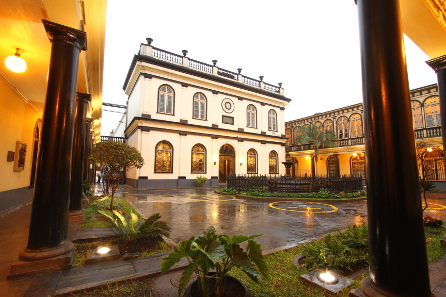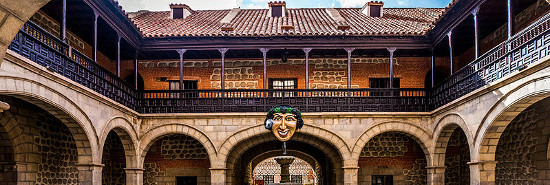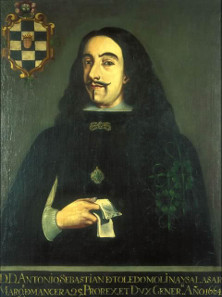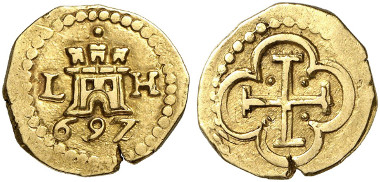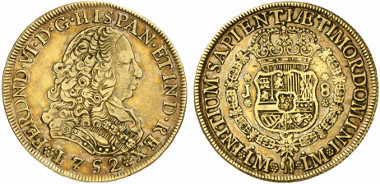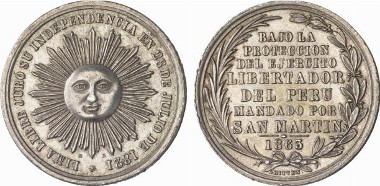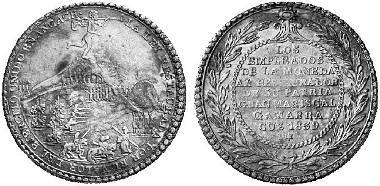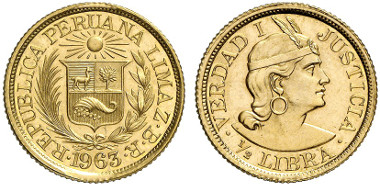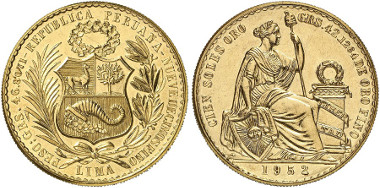By Carlos Contreras (Professor of Economics at the Pontificia Universidad Católica del Perú) and Carlos Morales (Professor at the Universidad Nacional Mayor de San Marcos)
December 23, 2015 –The Mint of Lima (known today as National Mint-CNM), founded by the Spanish government shortly after the arrival of Pizarro’s army, survived the independence because the economy and trade had to continue in the middle of the dramatic changes brought by the emancipation, breaking not only with Spain but also with the monarchical form of government.
Mint of Lima today. Photograph: National Reserve Bank of Peru.
The Royal Decree for its foundation was issued by King Philip II in Segovia, on August 21st, 1565, but it started minting coins three years later, in March 1568, first operating on one side of the government palace (Camprubí 1965: 12-13). Peru was then ruled by the president of the Audiencia de Lima, Lope García de Castro.
The foundation of the Mint of Lima
The Mint of Lima was the first mint established in South America and the third in all Spanish America. It was created with the explicit provision of minting only silver reales, which was evidence of the need to provide the young viceroy with a currency for local means of payment demanded by the repeatedly and daily trade. In the early years of Spanish settlement the conquistadors and settlers turned to using tejos and gold and silver bars as coins for purchases and sales, while indigenous people continued to use the ‘coins of the earth’ (seeds, fruits or animals), dating from Inca times. The usage of these coins continued at least until the time of Viceroy Francisco de Toledo (1569-1580), since the circulation of coins of the Mint of Lima coexisted with other currencies created by the inventiveness of the people due to shortages of cash. For example, it was frequent to substitute livestock animals for money in the regions of Cajamarca, Quito and Loja, (Salazar, 2009, Vol. II, p. 188).
Diego de Almagro, painting by Domingo Z. Mesa, 1873.
The creation of the Mint, thirty years after the founding of Lima, expressed the development reached by the Peruvian Spanish colony. The quarrels between factions of Almagro and Pizarro’s conquistadors had been settled (although the king would keep the memory of the battle of Las Salinas, when Diego de Almagro plundered the Cuzco royal box taking over the monarch’s revenues) and the chief magistrates began to displace the encomenderos as local authorities. The economy was transformed from a simple tax scheme based on the exaction by the encomendadores of Indians surplus to a precious metals producer’s economy, which favored a more dynamic type of circulation. Silver production was connected, for example, with livestock, using mules and llamas for loading and the demand for hides and tallow candles for transporting minerals and lighting of the tunnels.
On the other hand, the Spanish government tried to regulate the circulation of metal money known as pesos corrientes used daily with little state control. These coins were coarsely made by the Indians under the casting of the huayra technique bringing the substantial decline of the metal money refinement. The result was the discredit of the untested circulating (Lazo, 1992, T. I ,: p. 172) and the refusal of traders and wholesalers-entrepreneurs to accept the pesos made with indigenous technique. The Mint of Lima was to coin common silver prior to collection of the quinto real by the authorities, producing sealed cash. It could not coin gold or fleece (silver copper alloy). Its assignment was minting coins of one, two and four reales. Additionally, it was authorized that the pieces stamped in the mint were sent to Spain and the provinces of the crown and forced the treasurer of the mint to live permanently in the premises.
View of Potosi by Bernard Lens. Herman Moll, Map of South America, London 1715.
During its first term, the activities of the Mint were very irregular. There were problems in the quantity of minted silver reales per silver frame (a frame was equivalent to half a pound of silver), accusing employees of embezzlement. But it failed to prove their guilt; the authorities accepted that the minting in that period was very expensive and that wages paid to employees was very little, considering their efforts and responsibilities.
Peru, Philipp III, 1598-1621. 8 Reales n. d. M, Potosi. Ex Künker Auction 228 (March 12, 2013) lot. 3565.
In 1572 the Viceroy Francisco de Toledo decided to move the Mint to Potosi in today’s Bolivia. In the same year the mining base was adapted to the refining method of silver minerals through mercury treatment, replacing the method of smelting in huayra furnaces. The new method foretold great increases in silver production, which surely was one of the motives for this change. Although Lima was the main point of trade with Spain and, therefore, the place with the greatest demand for currency, Potosi was the silver producer center, which was the main consumable for the production of coins. The transportation of the unminted silver from Potosi to Lima encouraged smuggling and ‘losses’, which also forced the decision to manufacture the coins in Upper Peru. In March 28th, 1574 the Potosi mint issued its first coins.
Today’s National Mint of Bolovia, Potosí. Photograph: GameOfLight / https://creativecommons.org/licenses/by-sa/3.0/deed.en
In practice it happened, however, some kind of parallel operation of Lima and Potosi establishments. Thus, the Mint of Lima was reopened in 1577 to make lots that were accepted by the population and thus pressure the withdrawal of informal circulation currencies. It was not easy. These continued to be used by the mining and agricultural entrepreneurs. Both coins, minted by the Lima and Potosi mints (known as pesos ensayados) and the pesos corrientes circulated at the same time, establishing an equivalence of 10 reales corrientes for each peso ensayado. Lima mint was not strong enough to force the withdrawal of circulating cash, appreciating the fall of its exchange rate against the peso ensayado in more than 50% during the 1573-1575 triennium. The final withdrawal of the cash began from 1578, when the huge influx of the minted reales from the Potosi mint was noticed, which reached its peak between 1589 and 1595.
The introduction of the mercury treatment method for refining silver increased the productivity of the Potosi mines. The 21 million of silver pesos from 272 maravedis produced in this place from 1561 to 1570, increased to 63 and 69 million of pesos in the decades of 1581-1590 and 1591-1600, respectively (TePaske and Brown 2010; p. 181). This increase was more than threefold. Therefore, it was decided in 1588 to close the premises of the Mint of Lima. The mining area of Upper Peru shone like the new economic focus. Producers and mercury treatment miners who transformed the silver ores in silver bars had become large buyers of consumables such as salt, mercury, candles, wood, leather, animals, harness, millstones and other elements. Currency required by Lima could in any case be provided by the Potosi mint. It took 45 years to think about the possible reopening of the Mint of Lima, and almost 70 years to restart its coinage.
Antonio Sebastián Álvarez de Toledo, 25° Virrey de Nueva España, II Marqués de Mancera y Grande de España. Anonymous Picture of the 17th century. Wikipedia.
Re-opening of the Lima Mint in XVII Century
The mint was re-opened in July 1643, during the government of Viceroy Marqués de Mancera. The reasons for this were the lack of circulating money and smuggling of gold and silver pastes occurring in the low Peru. As the king did not heed this request, Viceroy Conde de Salvatierra reiterated it in July 1650. In these years there was a monetary crisis revealed by the lack of circulating money, smuggling, devaluation of the peso moclones (lower value Pesos from Potosi), hoarding of the new currency with title and law adjusted pesos (real columnar) and its revaluation against the barra ensayada, all of which altered the business activity. On September 10, 1658, despite of not having the royal authorization, the coinage was resumed.
Peru, Carlos II, 1665-1700. 1 Escudo 1697 L-H, Lima. Ex Künker Auction 260 (March 10, 2015) lot. 2076.
In this new period, the mint began to operate in the new premises, which is the current site. During the reopening, between 1659 and 1660, the first gold escudos were minted, having coined a total of 320.621 marcos and put into circulation reales worth an increasing 2.685.205 pesos. Another development that emerges in this period are the silver merchants, traders responsible for transporting pasta from the mining centers to cast centers where property rights were paid (Lazo, 1990: 6).
Viceroy Melchor de Navarra y Rocafull, Duke of Palata. From El Perú Ilustrado, ca. 1890.
In January 1684, the reopening of the Mint of Lima, was authorized by royal decree, under the government of Viceroy Melchor de Navarra y Rocafull, Duke of Palata. This time, the guidelines for the institution were more specific: it was given the right to coin all bars belonging to the royal treasury, or privates; both mints (Lima and Potosi) were urged to mint silver in their respective areas, regardless of the opposition of the Mint of Potosi that kept the monopoly of minting (Dargent, 1988: 56). The reopening of 1684 did not mean, however, the closing of the Potosi mint, which continued working in parallel.
The definite reopening of the mint was due to a fiscal crisis reflected in the decrease of remittances to the mainland, imperial decline of the Spanish monarchy, which could not avoid its political decline (Andrien 2011: 252), the growth of a provincial regional economy strengthened by controlling circuits of informal trade which began to show signs of wealth and, finally, the loss of the silver ‘pineapples’, which had become uncontrollable for authorities.
Peruvian gold bar, marked with fineness XX-dot and castle-and-stars tax stamp, from the 1715 fleet. Ex Daniel Frank Sedwick Treasure Auction 17 (2015), 252.
The Lima Mint under the Bourbones
The eighteenth century brought to power in Spain the Bourbones dynasty, which undertook a series of reforms in America aimed at increasing the peninsular economic growth, for which, they thought, the American colonies could provide substantial support. The results of this policy were the establishment of greater control, recentralization and colonialism in America. Regarding the monetary area, it was tried to increase the minting of small change and contain the loss of almost a third of the currency that went out from the provinces, without paying seigniorage to the royal treasury. To do this, traders would be forced to convert the paste into coinage, so that they did not have excuses not to do it and be able to trade in Portobelo (Panama) with the plata corriente. However, the progressive decline in tax collection and monetary production could not be prevented in the period 1684-1720. Following an old custom, the salaries of the officials of the colonial administration were paid in bar currency, challenging the legal provisions. Just in 1714, it was ordered through a Royal Agreement of Justice, to pay in coinage and not in pasta or bar, with some exceptions.
The silver rolling machine in Potosi, Bolivia, which certainly was very similar to the machines used in Lima. Photo: Martin St.-Amant / Wikipedia. CC-BY-SA-3.0
The most important transformations would come with the royal decrees of June 9th, 1728 and July 16th, 1730, which ordered to mechanize the coining in the mints, using rolling mills in replacement of the ‘hammers and scissors’ technique; it also began to use minting balance poles and lathes. The cost of manufacturing coins, which was private, was nationalized. The king took the coinage as a single entrepreneur, covering the total cost of minting and coinage of the old bars and tejos. The objectives were to double the productivity of work and improve the quality of the coins (Lazo 2006, TI 130, 233).
Peru, Fernando VI, 1746-1759. Escudos 1752 LM-LM, Lima. Ex Künker Auction 197 (September 28, 2011) lot. 6641.
The second transformation, in 1736, was to reduce by 50% the tax burden on mining production, which was in decline from the second half of the seventeenth century. Instead of the fifth of the production, it would pay the tithe. These reforms led to an improvement in the price of silver. Another important measure was the elimination of the silver merchants and sponsorship for the establishment of a development bank for mining (1747). The silver merchants, better known as ‘Masters of silver’, were those who were coining pasta legally, bringing them directly from the mining centers. They had earned this right, from the crown, as evidenced by the royal decree issued in December 1686. The merchants bought the silver produced in the mining centers of the Viceroyalty to mint it in some mint, mimicking the custom practiced in the House of Trade of Sevilla. Once the metal was coined, they bought with the same dies new bar and pineapple pieces and so the currency continued to circulate in the market. According to the grant made by the State, they were required to buy the silver pieces sold by the Royal Cashes at auctions every so often and take them to the Mint. They were considered true profiteers of the mining companies, obtaining great profits from their activities; therefore became an obstacle to the recovery of mining production, and their privilege was abolished in 1748. The abolition allowed the establishment of a trade and interchange network in the territory, forming large trading companies with wealthy merchants and factors and stores or public facilities for the purchase of pasta were opened.
Regarding development banks, this began when Potosi miners were organized in 1747 starting a company. The company’s objective was to create a bank with equity capital, to escape from the speculation of the silver merchants. With the contribution of capital from the Royal Treasury in 1752, the company was finally materialized, becoming a ‘bailout bank’ of Potosi azogueros. Later (1779) it became the Royal Bank of San Carlos in Potosi.
Peru. Macuquino 8 escudos, 1724. Ex Daniel Frank Sedwick, Treasure Auction 18 (2015), 14.
Another aspect of the reform was to increase the money supply in macuquinos values (manually made coin within the mints, in contrast to those produced on the new machines, which from the mid-eighteenth century were already perfectly round) in order to provide liquidity to the internal circulation fund of the colonial economy. This measure strengthened domestic transactions, since they could have a monetary fund that was not absorbed by the great ultramarine type of colonial trade, which rejected this coin.
Changes from independence
When the emancipation issue began, the employees of the Mint of Lima, followed other colonial institutions, by contributing with part of their salaries for the maintenance of the royal troops. The increase in military encounters led the same employees to enlisting in the militia. The Mint took a protective attitude with its operators and workers to avoid their enlisting in the army, through protests of its head to the viceroy of the situation. Finally, it was decided to make a list of those who would remain exempt from military services.
Peru, Republic since 1822. Silver medal 1863 by R. Britten, on the 42nd anniversary of independance from Spain. Ex Künker Auction 138 (March 11, 2008) lot. 5969.
The war of independence brought severe losses to the Mint, both in terms of staff (all the 14 spaniards of the 61 employees left Lima after the events of July 1821), and the machinery and equipment. Viceroy La Serna went to Cuzco, 1821, he took part of the machinery from the institution and general Canterac, which resumed Lima in 1823, did the same when he retired from the capital to Jauja (Camprubí 1965: 19-23). In 1825, the newly independent government gave the institution in concession to a British firm, though maintaining oversight and the right to conduct monetary production. Five years later, a new regulation was issued, replacing the previous of 1755. In this paper it was established the dependence of the mint to the executive power of the republic, through the office of the Ministry of Finance. A Board of Directors, headed by a Director, governed the destinies of the institution. The practice, however, was to yield at auction the manufacturing of the coins to a private, which would perform the work under the supervision of the Board. The position of Director replaced the position of the Superintendent that was included in the regulation of 1755, who reported directly to the viceroy (Camprubí 1965: 18, 24).
Peru, Republic since 1822. Silver medal of 4 reales 1839, issued by the Cuzco minting official, on the victory of General Gamarras over the president of the Peruvian-Bolivian Confederation. Ex Künker Auction 92 (June 22, 2004) lot. 1208.
The years between 1830 and the Saltpeter war were particularly agitated in the Peruvian monetary history. On the one hand, the coinage was decentralized, opening for various lapses minting offices in Cusco, Arequipa, Cerro de Pasco and Ayacucho (Luque 1991 Yábar 1996). On the other, the country experienced the arrival of the feeble Bolivian currency, which was really the reiteration of an existing monetary union from moving the mint of Lima to Potosi in 1572. The Bolivian currency, with lower content of silver, nestled in the country because it came to solve the problem of the exit of good money as compensation to the foreign trade inequity. The major quantity of importation compared with exportations paid off removing coins from the economy. The emptiness left by this exit was replaced with the Bolivian currency, which due to its lower content of silver, was rejected by the foreign trade.
In 1863, the currency left from the Spanish period was changed: the peso divided into eight reales for a new monetary unit: the sol, divided into ten dineros, which, the population continued calling reales. The exchange rate of the Sol was 1.25 pesos febles (the good ones did not circulate any more). Taking advantage of the tax wealth provided by the monopoly of guano, Balta’s government commissioned the purchase of new machinery for the Mint, including steam engines brought from England. The location of the mint was renovated in order to accommodate new equipment. But in 1870 there was a flood of paper money issued first by private banks, and afterwards by the government. The disorderly issuing produced strong price inflation for payment with paper money, which was further radicalized when the Saltpeter war exploded, Chilean occupation army refused to accept the bills as payment of quotas and taxes.
Peru, Republic since 1822. 1/2 Libra 1963. Ex Künker Auction 239 (October 10, 2013) lot. 5592.
After the end of the war, the country started to banish the ‘fiscal bill’ (as the paper sol was known), thus the Mint recovering its role as an issuer of national cash. In the late nineteenth century it worked busily producing silver soles of nine-tenths that the ailing national economy demanded for its functioning. In 1897, the Piérola’s government chose to take the gold standard captained in the world by Great Britain. The Peruvian Libra (Lp) was established as the national currency, becoming the silver sun a fraction (one-tenth) of it. It also decided to terminate the concession of minting money service to private companies, assuming the state the direct administration of the operations of the Mint.
Between 1885 and 1914, Peru had an all-metal coinage: gold coins of one pound and half a pound were the higher denomination units, while the silver soles and their fractions became the ‘change’. The Mint had to work hard due to the rapid growth of the economy during that period which demanded a significant increase of circulating. This situation changed in 1914, with the outbreak of the First World War, which led to hoarding and suspension of the gold trade in the world. Peru authorized the banks to issue ‘circular checks’ as a way to alleviate the lack of money, but also the minting of small nickel and copper small coins as a way to address the lack of small change. The Mint had to acquire adequate machinery to cope with this new task.
Absorption of the Mint by the Central Bank
The Great War (as contemporaries called the First World War) brought non reversible changes when it came to an end. One was the role and leadership of the state in monetary matters. Following this model, the Banco de la Reserva was established in Peru in 1922, intended to assume and ensure the issuance of the national currency. The new institution started immediately to issue paper Peruvian pounds; however, the global crisis that began in 1929 led to the abandonment of Lp and its replacement by the Sol de Oro. In the thirties the Mint resumed minting currency, bringing out new cash units of the Peruvian economy.
After the end of the war, the country started to banish the ‘fiscal bill’ (as the paper sol was known), thus the Mint recovering its role as an issuer of national cash. In the late nineteenth century it worked busily producing silver soles of nine-tenths that the ailing national economy demanded for its functioning. In 1897, the Piérola’s government chose to take the gold standard captained in the world by Great Britain. The Peruvian Libra (Lp) was established as the national currency, becoming the silver sun a fraction (one-tenth) of it. It also decided to terminate the concession of minting money service to private companies, assuming the state the direct administration of the operations of the Mint.
Between 1885 and 1914, Peru had an all-metal coinage: gold coins of one pound and half a pound were the higher denomination units, while the silver soles and their fractions became the ‘change’. The Mint had to work hard due to the rapid growth of the economy during that period which demanded a significant increase of circulating. This situation changed in 1914, with the outbreak of the First World War, which led to hoarding and suspension of the gold trade in the world. Peru authorized the banks to issue ‘circular checks’ as a way to alleviate the lack of money, but also the minting of small nickel and copper small coins as a way to address the lack of small change. The Mint had to acquire adequate machinery to cope with this new task.
Absorption of the Mint by the Central Bank
The Great War (as contemporaries called the First World War) brought non reversible changes when it came to an end. One was the role and leadership of the state in monetary matters. Following this model, the Banco de la Reserva was established in Peru in 1922, intended to assume and ensure the issuance of the national currency. The new institution started immediately to issue paper Peruvian pounds; however, the global crisis that began in 1929 led to the abandonment of Lp and its replacement by the Sol de Oro. In the thirties the Mint resumed minting currency, bringing out new cash units of the Peruvian economy.
Peru, Republic since 1822. 100 soles 1952. Ex Künker Auction 245 (March 10, 2014) lot. 668.
In 1943 took place the logical confluence between the Mint of Lima, and the young republican organization that was the Banco Central de Reserva del Peru. The bank was born to centralize the issuance of paper money and ensure the existence of the corresponding reserves (Ferrero 1962: 127). The Mint should continue issuing the currency which did not require reservation because it was made of precious metal. But after the great depression of the thirties, coins stopped being made of silver. Although they remained metal, they passed to be also fiduciary currency, meaning that its value was not based on its physical medium. The integration of the Mint within the Banco Central deepened in 1977, when the mint was constituted into the organization of the state as an industrial dependence, responsible for manufacturing the metal coin required by the country’s economy in the amounts provided by the board of the Bank.
The inflation of the seventies turned into hyperinflation in the last years of the next decade, pulling out from circulation metal coins. Its material value easily exceeded their face value, being used for welding pipes or ornament necklaces and jewelry. When the monetary disorder was overcome, the coins Nuevo Sol issued by the National Mint were again clinking in the pockets of Peruvians from the nineties until today. Today’s monetary ‘cone’ has become more complex than in the past, due to the issuing of coins from different materials depending of the denomination. The coins of two and five soles are bimetallic, following modern minting techniques.
References cited
Andrien, Kenneth (2011), Criswww.is y decadencia. El virreinato del Perú en el siglo XVII. Lima Banco Central de Reserva del Perú e Instituto de Estudios Peruanos.
Camprubí, Carlos (1965), Casa Nacional de Moneda. IV Centenario (1565-1965). Lima.
Dargent Chamot, Eduardo (1988), La moneda peruana en el siglo XVII. Universidad de Lima.
Ferrero Rebagliatti, Rómulo (1962), “La historia monetaria del Perú en el presente siglo”. Separata del libro Visión del Perú en el siglo XX, pp. 125-143. Lima.
Lazo García, Carlos (1992). Economía colonial y régimen monetario. Perú siglos XVI-XIX. Lima: Banco Central de Reserva del Perú. 3 tomos.
Lazo, Carlos y Luis Arana (1993), La casa de moneda de Lima frente al proceso numismática, tomo V. emancipador. Lima: Banco Central de Reserva del Perú. Cuadernos de historia.
Luque, Juvenal (1991), “Pasco: fugaz vida una ceca republicana, 1843-1857”. En La hornaza: taller nacional de acuñación de macuquina. Lima: Banco Central de Reserva del Perú, 1991.
Salazar-Soler, Carmen (2009) “Minería y moneda en la época colonial temprana”. En Carlos Contreras, ed., Compendio de historia económica del Perú, t. II. Economía del período colonial temprano. Lima: Banco Central de Reserva del Perú e Instituto de Estudios Peruanos.
TePaske, John y Kendall Brown (2010), A New World of Gold and Silver. Brill: Leiden/Boston.
Yábar, Francisco, (1996) El Inca de Oro: acuñaciones del Inca en las cecas de Lima y Ayacucho durante la Guerra del Pacífico. Lima: DESA.
Yábar, Francisco, (1996) Las últimas acuñaciones provinciales, 1883-1886: las Casas de Moneda de Cuzco y Arequipa después de la Guerra del Pacífico. Lima: Ediciones Impresora Amarilys.
Please find the official site of the Federal Reserve Bank of Peru here.
A wealth of information about the history of Peruvian currency is provided here and in this article.



